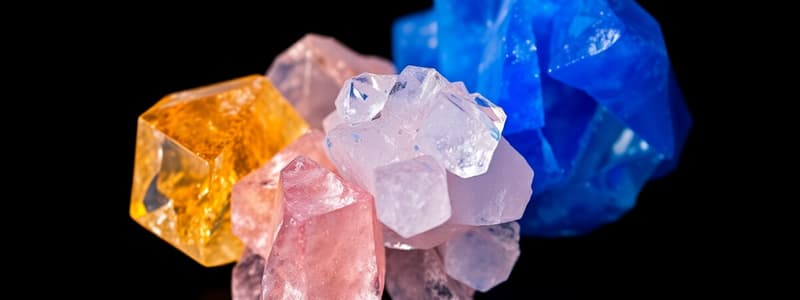Podcast
Questions and Answers
What characterizes crystalline solids compared to amorphous solids?
What characterizes crystalline solids compared to amorphous solids?
- They have randomly arranged particles.
- They exhibit well-defined shapes and edges. (correct)
- They lack electrostatic forces.
- They are always powders.
Which type of intermolecular force is primarily responsible for drug-target interactions?
Which type of intermolecular force is primarily responsible for drug-target interactions?
- Van der Waals forces
- Ion-dipole forces
- Induced dipole interactions
- Hydrogen bonding (correct)
What is the significance of the refractive index in identifying substances?
What is the significance of the refractive index in identifying substances?
- It determines the melting point of the substance.
- It assesses the solubility of the substance.
- It measures the speed of light through the substance. (correct)
- It indicates the density of the substance.
How do hydrates differ from solvates?
How do hydrates differ from solvates?
What describes the morphology of amorphous solids?
What describes the morphology of amorphous solids?
What role do intermolecular forces play in determining the melting point of a substance?
What role do intermolecular forces play in determining the melting point of a substance?
How does the refractive index vary among different substances, and why is it important?
How does the refractive index vary among different substances, and why is it important?
Explain the significance of crystal morphology in pharmacy.
Explain the significance of crystal morphology in pharmacy.
What are the expected intermolecular forces between hydroxyl (-OH) groups in two molecules?
What are the expected intermolecular forces between hydroxyl (-OH) groups in two molecules?
Identify one key difference between crystalline and amorphous solids based on particle arrangement.
Identify one key difference between crystalline and amorphous solids based on particle arrangement.
Flashcards
Crystalline Solids
Crystalline Solids
Solids with ordered arrays of ions, atoms, or molecules held together by electrostatic or non-covalent forces.
Amorphous Solids
Amorphous Solids
Solids with no ordered arrangement of constituent particles; they are often powdery and have curved surfaces.
Crystal Morphology
Crystal Morphology
The shape of a crystal, which can be relevant to understanding its structure and properties in pharmacy.
Solvates
Solvates
Signup and view all the flashcards
Hydrates
Hydrates
Signup and view all the flashcards
What are crystalline solids?
What are crystalline solids?
Signup and view all the flashcards
What are amorphous solids?
What are amorphous solids?
Signup and view all the flashcards
What's the difference between crystalline and amorphous solids?
What's the difference between crystalline and amorphous solids?
Signup and view all the flashcards
What are solvates?
What are solvates?
Signup and view all the flashcards
What are hydrates?
What are hydrates?
Signup and view all the flashcards
Study Notes
Crystalline & Amorphous Solids
- Crystalline solids have ordered arrays of ions, atoms, or molecules held together by electrostatic or non-electrostatic forces.
- Crystalline solids have well-defined faces and edges.
- Amorphous solids lack order in their arrangement of constituent particles.
- Amorphous solids are often powders.
- Some amorphous solids are super-cooled liquids with high viscosities (e.g., different types of glass).
- Amorphous solids are less thermodynamically stable than crystalline forms.
- Amorphous solids can float like a gas or flow like a liquid.
Crystalline Solids
- Molecules in crystalline materials are arranged in an ordered pattern, with this repeating pattern contained within the unit cell (smallest repeating unit).
- Crystalline solids have long-range ordering; the order of atoms extends throughout the entire crystal.
- Crystalline solids have narrow, and reproducible melting ranges.
- Crystalline solids have well-defined faces and edges.
- Crystalline solids' properties often depend on the orientation of the particles (anisotropic).
- Crystalline solids diffract X-rays, producing a distinctive diffraction pattern.
- Crystalline solids fracture or cleave under pressure.
Amorphous Solids
- Amorphous solids have broad, variable melting ranges (approximately 15°).
- Amorphous solids have no well-defined faces or edges.
- The properties of amorphous solids do not depend on particle orientation (isotropic).
- Amorphous solids do not diffract X-rays.
- Amorphous solids yield and flow under pressure.
Pharmaceutical Uses of Amorphous Solids
- Amorphous solids are used as packing materials (e.g., glass bottles).
- Amorphous solids are used as excipients (additives) in dosage forms, e.g., fused silica (thickening agent or good flow properties).
- Amorphous forms of active ingredients (e.g., Novobiocin), can be more therapeutically active and more soluble/dissolve quicker than their crystalline counterparts.
- Fine amorphous powders can be dispersed in liquids for use in injections and aerosol formulations.
Crystallization
- Crystallisation is the production of a single-component crystalline phase from a multi-component fluid phase.
- The process involves three steps:
- Supersaturation of the solution (creating a solution with more dissolved solute than a saturated solution at maximum solubility). This can be achieved by cooling a saturated solution, evaporating a saturated solution or by adding a precipitant (e.g. H₂O to an alcoholic solution).
- Formation of crystal nuclei (process of crystallization will start once crystals of the same/similar structure as the desirable drug are introduced, but will spontaneously occur beyond the metastable region).
- Crystal growth (drug concentration depletion from solution; occurs around growing crystals — resulting in a depletion of drug molecules in the solution; concentration gradient from the bulk solution to the crystal face; larger supersaturation = higher growth rate.
Pharmaceutical Importance
-
Morphology
-
Particle size
-
Polymorphism
-
Solvation
-
Hydration
- Affect how easily a drug can be injected, compressed for tablets. Ibuprofen (examples)
Studying That Suits You
Use AI to generate personalized quizzes and flashcards to suit your learning preferences.




